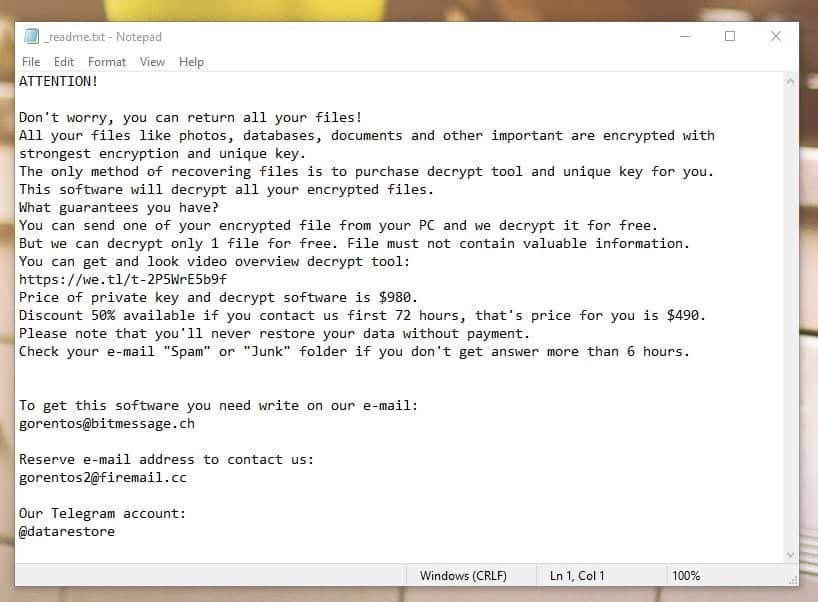This page aims to help you remove Nuksus for free. Our instructions also cover how any .Nuksus file can be recovered.
Ransomware viruses have been around for about three decades now, but it wasn’t until the last few years that the boom in this category of malware, we are witnessing today, really started. Security experts predict an exponential growth, with hundreds of new versions published each year, and those figures tend to keep growing. In specific, one of the latest versions is the Nuksus Ransomware, and we’ve received quite a few reports from our readers about it. Just like most other Ransomware viruses out there, Nuksus Ransomware encrypts the files on its victims’ machines, and then leaves demands for a ransom payment that needs to be carried out in exchange for decrypting the locked files.
All in all, it’s an extremely uncomfortable experience, where your computer is compromised, and you can also lose some of your most important information. So what should be done in case of such a Ransomware infection? First of all, it is essential that you remove it, and with the assistance of our manual removal guide from the current page, we can show you precisely how to do it. The guide also includes methods that may help you restore your files from system backups, but our advise is to first take a few more minutes to read the following details before you go to the removal and recovery instructions.
The .Nuksus virus
The Nuksus virus is the latest of the Stop strain of ransomware infections. It is currently the most spread one together with .Vesrato. The Nuksus virus rose at the same time as Vesrato, which is a change it tactic – up until now the malware creators targeted users mainly with one extension.

Ransomware is regarded as one of the most damaging and hazardous kinds of viruses in existence. And for this, there are a number of important reasons. One of them is the fact that they are extremely hard to locate once they make their way into your system. What is more, most antivirus programs can’t even detect them because of the encryption processes this malware uses.
The encryption itself is not a damaging process, and effectively serves as a means of protecting information from anyone who’s not authorized to access it. For example, it’s what is used to protect our financial details and other sensitive digital information. Additionally, there are usually very few, if any, symptoms of the infection. The encryption very often operates quietly, without specific symptoms. In some rare cases, the computer’s performance may get affected depending on the amount of data stored, as well as the PC’s processing power, resulting in a significant slowdown. However, this will not be enough to prompt most users to check for any suspicious processes in their Task Manager.
Another reason why malicious programs such as Nuksus or Nasoh can get away with what they do is because the hackers behind them request the ransom payment in Bitcoin (or other cryptocurrencies). Cryptocurrencies also use encryption as a means of shielding money senders and recipients from prying eyes. In the current case, the payments made through cryptocurrencies guarantee that no legal officials or law enforcement can monitor and bring to justice the cybercriminals.
The .Nuksus file encryption
The Nuksus files signify the completion of a strong encryption which shows the ransomware has finished taking over the file. The Nuksus files cannot be currently decrypted, but victims should expect that the official decryptors will soon cover victims with offline keys (more on that in our how to decrypt guide).

Users, though, have the power to stop the blackmailing scheme. “How?” – you may ask. Well, you can begin by refusing to pay the requested ransom. Besides, there is no assurance that you will be given access to your files if you pay. For one, the hackers may not even send you a key for decryption, which is often the case for many victims out there. Furthermore, having a decryption key does not automatically mean that you will retrieve your information effectively.
Therefore, what we would suggest you do is remove Nuksus, as this will prevent the malware from locking any new files you may create or download in your computer. After that, if you do not have backups stored on a cloud or on a external source, you can use the removal guide directions to potentially retrieve some of your files from system backups or through specialized free decryption tools.
SUMMARY:
Nuksus Virus Removal
Search Marquis is a high-profile hijacker – you might want to see if you’re not infected with it as well.
You can find the removal guide here.

Leave a Reply